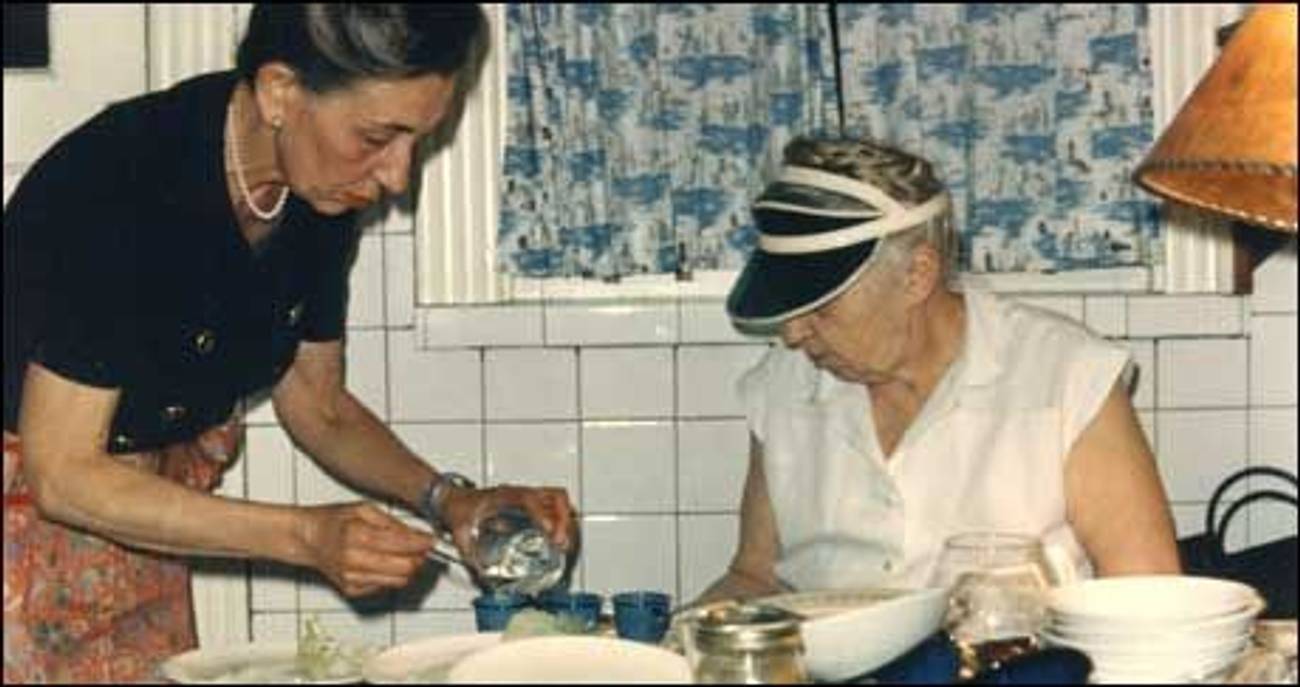Off the Menu
Why did my grandmother keep meticulous records of her Passover meals, but kept her maiden name a secret?




While sifting through my grandmother Lydia’s assortment of Haggadahs—a Maxwell House from 1937, a Mogen David from 1938—I came across a true mother lode of information: all her Passover menus dating back to 1957. Meticulously written on various slips of scrap paper, she noted who had attended each Seder and what had been served; most touchingly, she provided small sketches of the floral arrangements that graced each successive table.
All the staples made their appearances: homemade gefilte fish, served with freshly grated horseradish; chicken soup and matzo balls (two sets, one for the soup and another stuffed with meat, roasted in the oven); chicken and brisket (one year there was even a meat triumvirate, with a roast leg of lamb); a plethora of nut-and-egg-white desserts; and always compote. There were small concessions here and there to culinary trends (Japanese eggplant, anyone?) and the vagaries of produce availability. The guest list fluctuated similarly; after 1960, the names of my grandfather’s brother, Arthur, and his wife, Chesna, no longer appeared.
My grandmother was a gifted and prodigious cook, producing meals that inspired great devotion. I don’t want to say that her meals made up for severe shortcomings in other areas, such as having some difficulty in being nice to her children and learning not to cheat while playing cards with her grandchildren, but they did provide a template for hospitality and adherence to ritual and tradition that persists in my family to this day. The strangest thing about this is that my grandmother, born Lydia Esaeva, was not Jewish.
Her mother, Manya, a Russian-born Communist, had left her family’s estate outside of Pinsk after the Tsar’s forces forced her father and brother to dig their own graves before being buried alive. Born in Chicago in 1911, Lydia belonged to the Young Communist League as a teenage girl, became a professional ballet dancer, married a Jewish man, and took out a lifelong membership in Hadassah. She left the Party in the late 1940s, concerned by reports then coming out of the Soviet Union and the effect her membership might have on my father and aunt. That her maiden name appears in the above paragraph feels a little odd, as it was never allowed to be mentioned to those outside the family, for fear that somehow it might be used against her.
So what was the appeal that Passover held on my presumably atheist, non-Jewish grandmother? In the end, I think, it comes back to those menus: Passover is, above all, a narrative of redemption, the very foods we eat providing a culinary guide to the story of the Exodus. And that story of liberation is one in which the burdens of religious observance are subsumed into a larger performance not only of Jewish identity, but of a faith in the future, accessible and intelligible to all who sit round the Seder table.
In his unfinished 1824 novel, The Rabbi of Bacherach, Heinrich Heine calls Passover “mournfully merry, seriously playful, and mysteriously secret.” More than any other holiday, he wrote, Passover exerted a hold on all Jews, such that “even those Jews who have long fallen away from the faith of their fathers and run after gentile joys and honors, are moved to their hearts when by chance the old well-known tones of the Passover songs ring in their ears.” With his passionate interest in Jewish history and political liberalism, Heine (who turned to Christianity in 1825 in pursuit of career advancement, a choice he lived to regret deeply) found Passover the perfect encapsulation of those two elements, the past providing a clear template for the ethical behavior of the present.
I can only speculate as to whether or not it had a similar significance for Lydia. She died in November 1981, when I was 13, well before I would have been able to relate to her on an adult level. Perhaps she found a degree of resonance in Passover’s more universal themes. For all its Jewish specificity, Passover serves not only to remind us of our own liberation, but to jog us out of the complacency of everyday life and consider those who have yet to achieve their freedom. The 1942 New Haggadah, edited by Mordecai Kaplan, which my grandparents often used, says that “Pesach calls for us to be free, free from the tyranny of our own selves, free from the enslavement of poverty and inequality, free from the corroding hate that eats away the ties which unite mankind.” But when I asked my father why he thought his mother so enjoyed Passover, he simply replied, “Oh, she was a marvelous cook. She liked to make a nice meal.”
My husband and I now hold our own Seder. I make gefilte fish following Lydia’s recipe, which calls for enormous amounts of dill—more Russian than Jewish, perhaps. Her oak-leaf-and-acorn damask tablecloth rests on the table, as do copies of her typed, transliterated song sheets. We try to vary the menu every year, adding Italian and Sephardic specialties; of all the types of charoset we’ve tried, the Persian is the most popular, hands down. Yet each year I am drawn back to my grandmother’s menus, to her fastidious preservation of the order of the meal and the names of the guests. And each time, as the Seder opens, and we are commanded to eat the bread of affliction, I feel connected not only to the enormous weight of Jewish history, but to my grandmother Lydia.